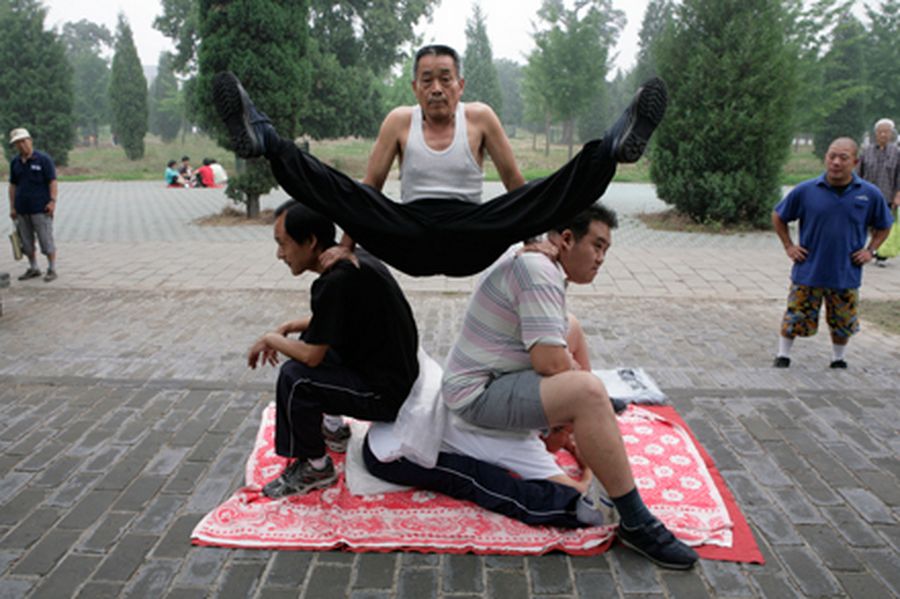The Samurai bond market is becoming a popular alternative source of funding for South Korean borrowers, while the high credit quality is tempting Japan’s conservative investors to broaden their horizon.

Source: Reuters/Grace Liang
Gao Mingyuan, 66, stretches himself with a team of Chinese martial arts fans during a morning exercise session at the Temple of Heaven park in Beijing
South Korean issuers have again been among the most active in the cross-border yen market and winning these mandates has turned into something of a battle for investment banks.
As Korean companies do large amounts of business in Japan, they always have large yen funding needs. However, other factors are making this market unusually competitive.
Firstly, since the financial crisis, much of the yen-denominated paper has been short-dated. This means it will most likely need to be refinanced sooner rather than later and that translates to another mandate for banks to think about winning.
Secondly, Korean issuers are extremely price sensitive, paving the way for banks to compete on price just as much as on relationships.
Foreign investment houses, reeling from the impact of the financial crisis in their home US and European markets, have been working hard to increase their presence in Japan, which has the world’s second largest capital market.
Citigroup, Bank of America Merrill Lynch, RBS, HSBC and even newcomer Credit-Agricole CIB have featured as joint leads on the Korean trades in Japan this year.
An added attraction is the prestige that comes from banks being able to do cross-border business and play on the global stage. Reputational gains notwithstanding, some deals can be profitable, too.
In May, for example, Export-Import Bank of Korea’s ¥100bn (US$1.3bn) well-taken three-part Samurai became the largest Asian ex-Australia yen offering and paid 35bp to joint leads BNP Paribas, Daiwa, Deutsche Bank, JP Morgan and Mizuho.
In July, after having established investor interest through extensive market pre-soundings, participants hailed the month as a “Korean festival”. Shinhan Bank, rated A1/A/A/A+ (Moody’s/S&P/Fitch/JCR), set the tone with a ¥35bn dual-tranche maiden public yen benchmark.
Shinhan had first-mover advantage on its side and no other borrower was able to take its issue size up to the ¥30bn level that Korea’s Ministry of Strategy and Finance granted.
Shinhan priced a two-year tenor at yen offer-side swaps plus 93bp and a three-year piece at plus 103bp, effectively drawing the starting line for the remaining July trio: Woori, rated A1/A–/A– (Moody’s/S&P/Fitch), Busan, rated A2/BBB+/A (Moody’s/Fitch/JCR), and Hana, rated A1/A/A+ (Moody’s/S&P/JCR).
“Shinhan’s was this season’s first commercial bank offering and, for that, we started marketing well before the Korean boom hit the market. We started with a non-deal roadshow in May and thorough marketing resulted in levels that were fair to US-dollar secondaries. That was important for the deal to be the gate-opener for the other banks,” said Ryutaro Hiroshima of the international debt syndicate at Mitsubishi UFJ Morgan Stanley, joint lead with JP Morgan, Mizuho and RBS.
From there onwards, issuers fought to beat their peers’ financing levels, meaning relatively expensive Samurai pricings versus secondary dollar pricing levels. This turned July into an exhausting month for lead managers as they battled for league table credit.
Bankers soon dubbed the battle between Korean policy and commercial bank issuers for tighter pricing as the ‘Korean War”, a far cry from the festive language used to describe the market a few weeks earlier.
“Perhaps, if the Korean banks were a little more generous, they could have easily grabbed a ¥30bn size each,” said a DCM banker involved with the July issuance. “However, in Korea, there is pride; a competition among issuers to price tighter than each other, so as to show they are all on the same page.”
High league table standing
It was an unprecedented month. One Samurai deal a week had been slated to price in July, allowing Korean issuers to amass ¥239.7bn of Samurai volumes in the year to the fourth week of July, according to data from Thomson Reuters.
Korean issuers now have a chance to take second place in overall Samurai bond issuance. This is important for them because it is the most transparent market for yen offerings and where deals serve as public benchmarks.
Supply will balloon to at least ¥259.7bn from 17 issues on July 26, when Hana Bank, expected to close the Korean yen-issuance wave, prices ¥30bn of paper. That will boost 2012 volumes to nearly 70% of the amount raised in full-year 2011.
In total international yen fundraisings, including Euroyen, Uridashi and private placements, Korea stands in fourth place for the first half of the year, with an 8.8% market share in terms of country breakdown, and ¥210bn of supply.
As no Korean corporate issuer has tested the yen market so far this year and, with expectations that the likes of Korea Gas, Posco and KT may come to market, there may well be a lot more heated competition before the year is out.
